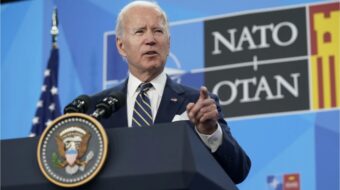
Latin American and Caribbean cooperation with China serves economic needs on both sides. Tightening of those nations’ relations with China also serves a political goal long articulated by the left-leaning Venezuelan, Ecuadorian, and Bolivian governments. Their spokespersons have frequently called for a mufti-polar international order to replace U.S. ascendency prevailing since the fall of the Soviet Bloc.
Strengthened economic ties between nations of the region and China were on display at the inaugural meeting of the ministerial forum of CELAC (Community of Latin American and Caribbean States) taking place in Beijing, China on Jan. 8-9. Chinese President Xi Jinping, present on both days, predicted trade volume would double over the coming decade and annual bilateral trade with the region would rise by $500 billion. Chinese investment, he said, would reach $250,000 billion. China now is the largest foreign buyer of Venezuelan oil, Chilean copper and Argentinian soybeans.
Xi Jinping anticipates “a shared Chinese – CELAC destiny for the consolidation, development, and transformation of peoples.” All but three of the alliance’s 33- member states were present.
Prior to the CELAC meeting, Venezuelan President Nicolas Maduro conferred with President Xi Jinping. Maduro announced on Jan. 7 that China would be adding $20 billion in new investments to $45 billion already invested over the past 10 years. He indicated the money would go toward “social, developmental and industrial projects including the building of 1,500 new schools in Venezuela and the expansion of operations in the Orinoco oil belt.” Venezuela’s current rate of crude oil exports to China – 524,000 barrels per day – will double by 2016. Almost half of that amount goes toward repayment of previous loans.
According to Venezuelan Vice president Jorge Arreaza, who accompanied Maduro, “China is a great potential, and it is not imperialist. It … wants for all of us to have respectable and dignified living standards.”
Venezuela will be using the loans to build capacity to accommodate consumer spending that is growing. Rising demand there for food, for example, has outstripped a threefold increase over 15 years in agricultural production. Venezuela’s budget for 2015 promises expanded tourist and transportation services and “vast sums” for higher education and pensions.
Bolivian Foreign minister David Choquehuanca, interviewed in Beijing, indicated Chinese companies are already involved in highway construction, oil and gas production, and sugar cane processing in Bolivia. China will be investing an additional $500 million in his country, the minister reported. As reported by Prensa Latina, He commended China for “establishing respectful relations, but without conditions, sincere, that allow us to grow, but also enables us to take certain common positions of a multilateral nature.” Bolivia, he said, has eased entry requirements for Chinese visitors, and increased the number of Bolivian students studying in China.
Ecuador, in turn, reported on agreements for $7.5 billion in new loans from China. After its default on $3.2 billion in foreign debt in 2008, Ecuador was able to borrow over $11 billion from China, applying some of it to servicing other Ecuadorian debts. Ecuador exports up to 90 percent of its oil to China, which is Ecuador’s top investment source. Much of the funding supports extraction of natural resources.
Yet China’s burgeoning economic ties with Brazil overshadow Chinese trade and investments in the other three countries, expanding though they may be. Bilateral trade in 2013 exceeded $80 billion. Importing Brazilian iron ore, agricultural commodities, and hydrocarbon resources, China replaced the United States as Brazil’s leading trade partner in 2009. China depends on Brazil for 22.1 percent of the steel it consumes. Having loaned $20 billion in 2010, China is now Brazil’s leading foreign investor.
In April, 1948, the United States assembled Latin American and Caribbean nations in Bogotá, Colombia to establish the Organization of American States (OAS). The U.S. purpose was to line them up to fight cold war against the Soviet Union. In April, 2015, the OAS holds its Summit of the Americas in Panama. Surely the region’s now firm ties with China, founded on interdependence and multilateralism, will go a long way this time toward immunizing member states against dictates from their northern neighbor.
Photo: Chinese President Xi Jinping, right walks with Costa Rica’s President Luis Guillermo Solis as they arrive at the opening ceremony to a two-day meeting between China and Latin American and Caribbean countries held at the Great Hall of the People in Beijing, China, Thursday, Jan. 8, 2015. Chinese President Xi Jinping hailed burgeoning ties Thursday with Latin America, pledging to use his country’s economic clout to support billions of dollars in regional projects and almost double two-way trade to $500 billion over the next 10 years. | Ng Han Guan/AP












Comments